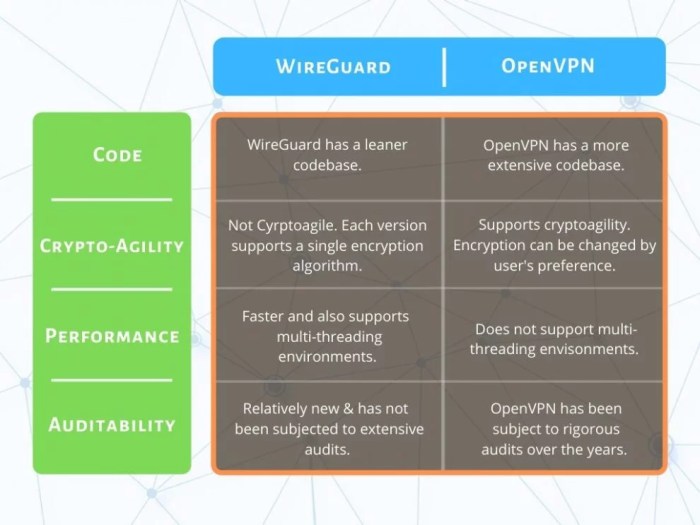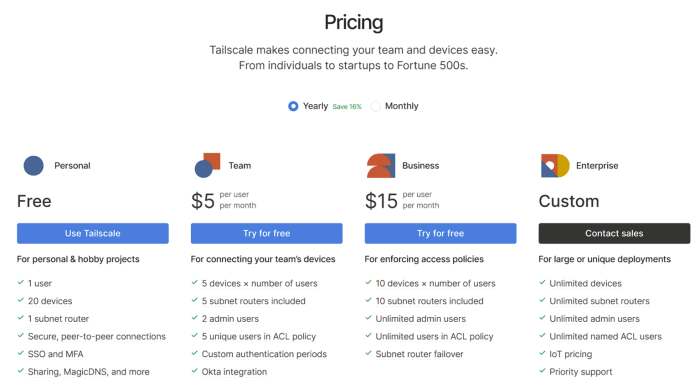In the realm of secure and reliable networking, the debate between Tailscale, WireGuard, and OpenVPN rages on. These three powerhouses offer varying strengths and approaches to virtual private networking (VPN), catering to diverse use cases and requirements. This comprehensive comparison will delve into their technical intricacies, performance metrics, ease of use, and more, empowering you to make an informed decision for your VPN needs.
Whether you’re a seasoned IT professional or a home user seeking enhanced online privacy, this analysis will provide invaluable insights into the strengths and weaknesses of Tailscale, WireGuard, and OpenVPN. Let’s dive into the depths of their technological prowess and uncover the ideal solution for your unique networking demands.
Technical Comparison
Tailscale, WireGuard, and OpenVPN are three popular VPN solutions with distinct technical approaches. Let’s explore their underlying differences in encryption, tunneling, and security.
Tailscale employs a proprietary WireGuard-based protocol for encryption and tunneling. It offers ease of use and seamless device management, making it suitable for small teams and remote access scenarios.
WireGuard is a modern and lightweight VPN protocol known for its speed and simplicity. It uses ChaCha20 for encryption, Curve25519 for key exchange, and BLAKE2s for hashing, providing strong security and performance.
OpenVPN, on the other hand, is an established and widely used VPN protocol. It supports a variety of encryption algorithms, including AES-256, and offers flexible configuration options. However, it may be more complex to set up and manage than Tailscale or WireGuard.
Encryption Protocols
- Tailscale: WireGuard-based protocol
- WireGuard: ChaCha20, Curve25519, BLAKE2s
- OpenVPN: AES-256, AES-128, Blowfish, etc.
Tunneling Mechanisms
- Tailscale: WireGuard-based
- WireGuard: UDP-based
- OpenVPN: TCP- or UDP-based
Security Features
- Tailscale: Automatic key management, device authentication, and network access control
- WireGuard: Built-in firewall, IP address randomization, and ephemeral key generation
- OpenVPN: Customizable cipher suites, certificate-based authentication, and support for various tunneling protocols
| Feature | Tailscale | WireGuard | OpenVPN |
|---|---|---|---|
| Encryption Protocol | WireGuard-based | ChaCha20, Curve25519, BLAKE2s | AES-256, AES-128, Blowfish, etc. |
| Tunneling Mechanism | WireGuard-based | UDP-based | TCP- or UDP-based |
| Device Authentication | Yes | Yes | Yes |
| Network Access Control | Yes | No | Yes |
| Automatic Key Management | Yes | No | No |
Performance and Scalability
The performance of Tailscale, WireGuard, and OpenVPN can vary depending on the specific use case and network conditions. In general, WireGuard tends to offer the best connection speeds and lowest latency, followed by Tailscale and OpenVPN. However, OpenVPN is known for its stability and scalability, making it a good choice for large-scale deployments.
Connection Speeds
WireGuard typically provides the fastest connection speeds, as it uses a modern and efficient encryption protocol. Tailscale also offers good connection speeds, but it may be slightly slower than WireGuard in some cases. OpenVPN is generally the slowest of the three, but it can still provide acceptable speeds for most use cases.
Latency
WireGuard also has the lowest latency, which is the amount of time it takes for a packet to travel from one point to another. Tailscale’s latency is typically higher than WireGuard’s, but it is still lower than OpenVPN’s. OpenVPN has the highest latency of the three, but it is still suitable for most applications.
Scalability
OpenVPN is the most scalable of the three, as it can support a large number of concurrent connections. Tailscale is also scalable, but it may not be able to handle as many connections as OpenVPN. WireGuard is the least scalable of the three, but it is still suitable for most small to medium-sized deployments.
Real-World Examples
- Remote Access: WireGuard’s fast connection speeds and low latency make it a good choice for remote access applications, where users need to access their work resources from anywhere.
- Cloud Connectivity: Tailscale’s scalability and ease of use make it a good choice for connecting to cloud-based resources, such as virtual machines and containers.
- Large-Scale Deployments: OpenVPN’s stability and scalability make it a good choice for large-scale deployments, such as corporate networks and data centers.
Ease of Use and Management
Tailscale, WireGuard, and OpenVPN offer varying levels of user-friendliness and management complexity.
User Interface
Tailscale boasts an intuitive web interface that simplifies configuration and management. WireGuard, while primarily command-line based, provides a user-friendly graphical interface (wg-quick) for ease of use. OpenVPN requires manual configuration via text files, making it less user-friendly.
Configuration Process
Tailscale’s zero-configuration feature eliminates the need for manual setup, making it effortless for beginners. WireGuard’s simple configuration process involves generating keys and adding a few lines to a configuration file. OpenVPN’s complex configuration requires extensive knowledge of networking and security protocols.
Learning Curve
Tailscale’s simplicity makes it easy for users to get started quickly. WireGuard’s moderate learning curve requires some technical understanding. OpenVPN’s steep learning curve can be challenging for non-technical users.
Documentation Quality
Tailscale’s comprehensive documentation provides clear instructions and examples. WireGuard’s documentation is well-organized but may require additional resources for beginners. OpenVPN’s extensive documentation can be overwhelming for non-experts.
Support Resources
Tailscale offers a dedicated support team and active community forum. WireGuard relies primarily on online forums and community support. OpenVPN has limited official support, but a large user community provides assistance.
Impact on Different User Types
Tailscale’s ease of use makes it ideal for non-technical users and those seeking a hassle-free setup. WireGuard’s balance of user-friendliness and technical depth appeals to both beginners and experienced users. OpenVPN’s complexity suits advanced users with a deep understanding of networking.
Platform Support
Tailscale, WireGuard, and OpenVPN are all cross-platform solutions that support a wide range of operating systems, devices, and cloud environments.
Operating Systems
Tailscale supports all major operating systems, including Windows, macOS, Linux, iOS, and Android. WireGuard is also compatible with these operating systems, with the exception of iOS. OpenVPN supports a slightly wider range of operating systems, including FreeBSD and Solaris, in addition to the ones supported by Tailscale and WireGuard.
Devices
Tailscale and WireGuard can be used on a variety of devices, including laptops, desktops, smartphones, tablets, and routers. OpenVPN has a slightly wider range of supported devices, including embedded systems and network appliances.
Cloud Environments
All three solutions can be deployed in cloud environments, such as AWS, Azure, and GCP. Tailscale and WireGuard are particularly well-suited for cloud environments due to their ease of deployment and management. OpenVPN can also be deployed in cloud environments, but it requires more configuration and management effort.|
Feature | Tailscale | WireGuard | OpenVPN ||—|—|—|—|| Operating Systems | Windows, macOS, Linux, iOS, Android | Windows, macOS, Linux (except iOS) | Windows, macOS, Linux, FreeBSD, Solaris || Devices | Laptops, desktops, smartphones, tablets, routers | Laptops, desktops, smartphones, tablets, routers | Laptops, desktops, smartphones, tablets, routers, embedded systems, network appliances || Cloud Environments | AWS, Azure, GCP | AWS, Azure, GCP | AWS, Azure, GCP |
Cost and Licensing
Tailscale, WireGuard, and OpenVPN adopt distinct pricing models and licensing terms. Understanding their cost structures and usage limitations is crucial for making informed decisions.
Tailscale offers a freemium model, with a free tier for personal use and paid tiers for business and enterprise users. The free tier has certain limitations, such as a maximum of 20 devices and 100 GB of data transfer per month.
Paid tiers start at $10 per user per month and offer additional features such as unlimited devices, increased data transfer limits, and advanced security options.
WireGuard
WireGuard is an open-source software that is free to use. However, users may incur costs associated with deploying and managing WireGuard, such as purchasing hardware or cloud resources. There are also commercial offerings from third-party vendors that provide managed WireGuard services, which typically charge a monthly fee.
OpenVPN
OpenVPN is also open-source and free to use. Similar to WireGuard, users may need to invest in hardware or cloud resources to deploy and manage OpenVPN. Additionally, OpenVPN offers commercial support and enterprise-grade features through its paid Access Server product, which starts at $120 per year for a single server license.
| Tailscale | WireGuard | OpenVPN | |
|---|---|---|---|
| Pricing Model | Freemium (free tier with limitations) | Open-source (free to use) | Open-source (free to use); commercial support and enterprise features available |
| Free Tier | Yes (20 devices, 100 GB data/month) | Yes | Yes |
| Paid Tiers | Yes (starting at $10/user/month) | Commercial offerings from third-party vendors | Access Server (starting at $120/year for a single server license) |
Security Considerations

Tailscale, WireGuard, and OpenVPN prioritize security by implementing robust encryption algorithms, authentication protocols, and authorization mechanisms. However, each tool has its unique strengths and vulnerabilities that users should be aware of to ensure optimal protection.
Encryption
- Tailscale utilizes AES-256-GCM encryption, providing strong data protection during transmission.
- WireGuard employs ChaCha20 and Poly1305 algorithms, known for their speed and security.
- OpenVPN supports multiple encryption algorithms, including AES-256-CBC and AES-256-GCM, offering flexibility and compatibility.
Authentication
- Tailscale uses ephemeral keys for device authentication, reducing the risk of compromised credentials.
- WireGuard relies on public-key cryptography for authentication, ensuring secure key exchange.
- OpenVPN supports various authentication methods, including certificate-based and password-based authentication.
Authorization
- Tailscale’s access control lists (ACLs) enable granular authorization, allowing administrators to define specific permissions for different users.
- WireGuard’s authorization is based on the allowed IP addresses and ports, providing a straightforward approach.
- OpenVPN offers advanced authorization features, such as RADIUS and LDAP integration, for more complex environments.
Recommendations for Mitigating Security Risks
- Use strong encryption algorithms and key lengths to protect data.
- Implement two-factor authentication (2FA) to enhance authentication security.
- Regularly update software and patch vulnerabilities to address security flaws.
- Monitor network traffic for suspicious activities and unauthorized access.
- Consider using a network intrusion detection system (NIDS) to detect and prevent security breaches.
By understanding the security strengths and vulnerabilities of Tailscale, WireGuard, and OpenVPN, users can make informed decisions and implement appropriate security measures to protect their networks and data.
Use Cases and Applications
Tailscale, WireGuard, and OpenVPN are versatile tools that can be deployed in a wide range of scenarios. Each has its strengths and weaknesses, making it suitable for different use cases and applications.
One common use case for all three solutions is remote access. They allow users to securely connect to private networks from anywhere with an internet connection. This is particularly useful for employees who need to access company resources while working from home or on the go.
Site-to-Site Connectivity
Another important use case is site-to-site connectivity. This involves establishing a secure connection between two or more physical locations, such as offices or data centers. Tailscale, WireGuard, and OpenVPN can all be used to create site-to-site VPNs, allowing users to share resources and collaborate across different locations.
Cloud Networking
In the cloud computing era, Tailscale, WireGuard, and OpenVPN are also used for cloud networking. They can be deployed to connect cloud-based resources, such as virtual machines and containers, to on-premises networks. This enables organizations to extend their existing network infrastructure to the cloud, providing secure and reliable access to cloud-based applications and services.
Real-World Examples
- Tailscale is used by companies like Dropbox, GitHub, and Asana to provide secure remote access to their employees.
- WireGuard is used by companies like Cloudflare and Fastly to establish high-performance site-to-site VPNs.
- OpenVPN is used by organizations of all sizes to create secure VPNs for a variety of purposes, including remote access, site-to-site connectivity, and cloud networking.
Community and Support

Tailscale, WireGuard, and OpenVPN all have active online communities and support resources to assist users with troubleshooting, customization, and knowledge sharing.Tailscale offers a dedicated support forum where users can ask questions, share experiences, and get help from the Tailscale team and community members.
The Tailscale documentation is extensive and well-written, covering a wide range of topics from basic setup to advanced configuration. Additionally, Tailscale has a thriving developer community that contributes to the project and provides support through open-source forums and mailing lists.WireGuard
also has a dedicated support forum where users can get help from the WireGuard team and community members. The WireGuard documentation is concise and easy to follow, providing clear instructions for setup and configuration. WireGuard has a strong developer community that actively contributes to the project and provides support through open-source forums and mailing lists.OpenVPN
has a large and active online community, with multiple forums and mailing lists where users can get help and share knowledge. The OpenVPN documentation is comprehensive and covers all aspects of the software, from basic setup to advanced configuration. OpenVPN has a strong developer community that contributes to the project and provides support through open-source forums and mailing lists.
Future Trends and Developments
The VPN industry is constantly evolving, with new technologies and user demands emerging all the time. Tailscale, WireGuard, and OpenVPN are all well-positioned to adapt to these changes and continue to be leading VPN solutions.
One of the most significant trends in the VPN industry is the increasing adoption of cloud-based VPNs. Cloud-based VPNs offer several advantages over traditional on-premises VPNs, including scalability, flexibility, and ease of management. Tailscale is a cloud-based VPN that is well-positioned to take advantage of this trend.
Another trend in the VPN industry is the increasing demand for VPNs that are compatible with mobile devices. More and more people are using their mobile devices to access the internet, and they need VPNs that can protect their data on the go.
WireGuard is a VPN that is specifically designed for mobile devices, and it is likely to become increasingly popular as the demand for mobile VPNs grows.
Emerging Technologies
Several emerging technologies are likely to disrupt the VPN market in the coming years. These technologies include:
- Quantum computing: Quantum computers could be used to break the encryption used by VPNs. This would make VPNs less secure and could lead to a decline in their use.
- Blockchain technology: Blockchain technology could be used to create decentralized VPNs. Decentralized VPNs would be more secure and resistant to censorship than traditional VPNs.
- Artificial intelligence (AI): AI could be used to improve the performance and security of VPNs. AI could also be used to develop new VPN features that are not possible with traditional VPNs.
Conclusion

After thoroughly comparing Tailscale, WireGuard, and OpenVPN, we can summarize their key findings:
Tailscale excels in ease of use, scalability, and platform support, making it ideal for remote teams and businesses seeking a simple and flexible VPN solution. WireGuard stands out for its impressive performance and security, appealing to users who prioritize speed and encryption strength.
OpenVPN remains a robust and customizable VPN option, suitable for advanced users and complex network configurations.
To select the best VPN solution for your specific needs, consider the following recommendations:
- Ease of use and scalability: Tailscale is the clear choice for users seeking a hassle-free and scalable VPN experience.
- Performance and security: WireGuard is the optimal option for users prioritizing blazing-fast speeds and robust encryption.
- Customizability and advanced features: OpenVPN is the ideal choice for users requiring granular control and advanced customization options.
Final Summary
Our in-depth comparison of Tailscale, WireGuard, and OpenVPN has shed light on their distinct advantages and limitations. The choice between these VPN solutions ultimately depends on your specific requirements and preferences. For lightning-fast speeds and ease of deployment, WireGuard emerges as a top contender.
If you prioritize robust security and a user-friendly interface, Tailscale is an excellent choice. And for open-source enthusiasts seeking advanced customization options, OpenVPN remains a formidable option.
As the VPN landscape continues to evolve, it’s crucial to stay abreast of emerging technologies and industry trends. By understanding the strengths and weaknesses of Tailscale, WireGuard, and OpenVPN, you can make informed decisions about your VPN strategy and ensure seamless, secure, and high-performance networking for years to come.
